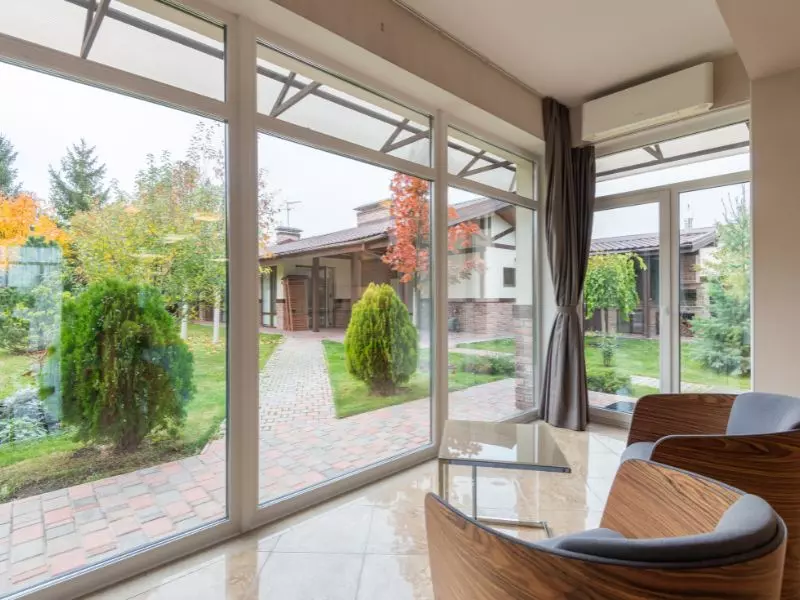
As we usher in an era where our homes are as smart as our phones, smart windows are gaining ground.
These aren't your average windows; they're a peek into the future, where convenience, efficiency, and comfort are at your fingertips. But what makes these windows 'smart,' and why are they becoming necessary in modern living spaces?
Understanding Smart Windows
Smart windows, in the simplest terms, are glass panes that change their light transmission properties at the flick of a switch, a voice command, or even automatically. Whether dimming the sunlight on a scorching day or enjoying an unobstructed view on a clear one, these windows adjust to your life. The magic lies in their various types - electrochromic, photochromic, thermochromic, and liquid crystal, each with unique properties and ways of operation.
Understanding the Types of Smart Windows
While the term "smart windows" feels futuristic, it encompasses several technologies, each with unique characteristics and mechanisms. Here's a breakdown of the different types of smart windows to help you understand what's behind the glass:
Electrochromic Windows:
Electrochromic windows, often called "electrically switchable," use a low electricity voltage to adjust the window's tint. With the touch of a button, you control the opacity of the glass, making it as transparent or dark as you wish. They function by moving ions from one layer of the glass to another, changing its color. This process allows for smooth transitions between light and dark states, providing precise control over light levels.
Photochromic Windows:
Imagine windows that adapt to the sunlight—getting darker with bright sunlight and more transparent as it gets cloudy. That's the magic of photochromic windows, a perfect blend of comfort and convenience. These windows respond to UV light, adjusting their tint based on the intensity of sunlight. However, they don't require manual operation, making them an energy-efficient option that adapts to changing environmental conditions.
Thermochromic Windows:
Thermochromic windows are like mood rings for your home, changing their tint based on temperature. They're designed to be highly responsive to weather conditions, making them a smart choice for energy conservation. The secret lies in the materials used in the window, which react to heat levels. As the temperature rises, the window becomes darker to block sunlight and vice versa, working autonomously without needing electrical input.
Liquid Crystal Windows:
For those seeking instant privacy, liquid crystal windows are your go-to. At the flick of a switch, these windows can change from transparent to opaque, blurring the lines between spaces. These windows house liquid crystal molecules between glass layers. When electricity is applied, the crystals align to let light pass through. Once the power is off, they return to their scattered state, turning the glass opaque.
These technologies offer unique benefits, from energy savings to enhanced comfort and privacy. The key is understanding your needs and preferences to select the smart window technology that aligns with your lifestyle.
The Benefits of Smart Windows
The perks of smart windows go far beyond the cool factor:
Energy Efficiency
They're champions of climate control, keeping your space cool or warm by regulating the light that passes through, which means less work for your air conditioning or heating system.
Comfort and Convenience
Forget getting up to draw the curtains. Smart windows can be synced with your home systems to adjust automatically or on command, enhancing your living experience.
Privacy at the Switch of a Button
Turning windows from transparent to opaque means you can ditch the bulky curtains and enjoy instant privacy without compromising on style.
UV Protection
Enjoy natural light without worry, as smart windows can shield your interior from harmful UV rays, protecting you and preventing furniture fade.
Smart Windows and Sustainable Living
Smart windows are a nod to the future, aligning with global sustainability goals. They play a significant role in green building standards, contributing to certifications like LEED. By reducing energy consumption, they're not just cutting down your bills but part of a larger movement towards environmental responsibility.
Cost Analysis
Investing in smart windows requires upfront capital but is a long-term play. Your energy bills take a nosedive, and with potential incentives from eco-friendly initiatives, they make financial sense. They are a modern alternative to traditional window treatments in function and aesthetic appeal.
Integration with Smart Home Ecosystems
Smart windows gel seamlessly with your smart home setup. Whether it's Alexa, Google Assistant, or another system, your windows can respond to your routine, the weather, or whims, just like your other smart devices.
Customization and Personalization
Today's smart windows offer a buffet of customization options. From sizes and colors to varying control methods, they can be tailored to fit your home's personality. And with features like scheduled tinting, your windows work with you, adapting to your schedule and lifestyle preferences.
Installation and Maintenance
Getting smart windows fitted is a task for the pros, ensuring everything from the wiring to the positioning is spot-on. Post-installation, you're looking at a low-maintenance relationship with durability that competes with standard windows, keeping your living spaces hassle-free.
The Future of Smart Windows
The smart window industry is advancing, with research diving into even more advanced features like harvesting solar energy or integrating with security systems. The potential is vast, signaling that we're just at the beginning of what smart windows can contribute to modern living.
Conclusion
Smart windows represent a shift in how we interact with our living spaces. They stand at the intersection of comfort, innovation, and sustainability, answering a growing demand for smarter, more efficient homes. As we continue to embrace technology in every aspect of our lives, the transition to features like smart windows seems not just sensible but inevitable.
